
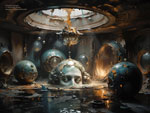


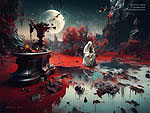




What is Neosurrealism?
Is this a new discovery or a well-forgotten old one? Surrealism vs Neo-surrealism.
The Neo-Surrealist Manifesto.


“Everything you can imagine is real.” ― Pablo Picasso
Crafting an essay on the evolution of visual art proves to be a formidable challenge, exposing me to a barrage of criticism from every conceivable angle. Art critics each possess unique perspectives, while the artists remain unfettered by predefined guidelines, instead propelled solely by their visions and inspirations. The general audience, in turn, exhibits a lack of appetite for theories or art history. I hesitate to categorize this discourse as a manifest, as manifestos conventionally mark the inception of a movement.
Neosurrealism, however, eschews the traditional need for a manifesto. It has already existed, exists presently, and will persist independently of any artistic proclamations I may proffer. Nevertheless, it strikes me that it is necessary to bring coherence and elucidation to the multifarious trends, terminologies, and myriad interpretations that have arisen in the progression of modern surrealism. Does this movement even exist in a discernible form, or is it simply a continuation of the classical surrealism from the early 20th century? If it does exist, what sets it apart, how has it evolved, and what are its distinctive attributes?

 |
Subliminal Message or Optical Illusion of Conscious Perception 2018 - George Grie* |
Let's begin with a brief terminology primer to aid those unacquainted with fine arts theory. Traditional art categories encompass visual arts (encompassing painting, drawing, sculpture, and the like), graphic arts (encompassing painting, drawing, design, and other forms expressed on flat surfaces), plastic arts (including sculpture and modeling), and decorative arts (such as enamel work, furniture design, and mosaics). It's crucial to discern, for instance, that painting, drawing, and sculpture are specific branches within the realm of visual arts, while the term "fine art" designates a category of artwork characterized by distinct themes, such as historical, animalistic, still-life, and portraiture. Let's ensure these definitions are crystal clear.
Surrealism diverges from the typical notion of a genre, category, or branch in the context of fine arts. Instead, it finds its place as an art movement, or stream, to be precise. Surrealism constitutes a segment of the broader cultural movement known as Modernism, which spanned from 1880 to 1965. An art movement is a well-defined artistic style guided by a common philosophy or objective, adhered to by a community of artists. Such movements encompass various branches and genres within visual arts and extend to literature and theater. The term "movement" itself suggests a sense of progression or direction, with these movements proving to be diverse and often unpredictable, susceptible to change, and capable of branching into various, unanticipated components.
Numerous visual art movements exhibit varying degrees of affinity, with some sharing spiritual connections while others remain distinctly dissimilar. For instance:
• The Impressionists aspired to craft methodologies and techniques that could faithfully and dynamically capture the world's authenticity, conveying its transient impressions in the most natural manner possible.
• Romanticism's representatives championed the intrinsic worth of an individual's spiritual and creative existence, emphasizing potent emotions and well-defined characters, often imbuing nature with a spiritual and therapeutic quality.
 |
The Persistence of Memory 1931 - Salvador Dali |
• Cubist artists endeavored to disassemble three-dimensional objects into elemental components, subsequently reassembling them on canvas in a two-dimensional format.
• Surrealists are readily identified by their usage of allusions and paradoxical amalgamations of forms. Surrealism is a fusion of dreams and reality, transformed into an absolute truth or a super-reality. Surrealists artfully juxtaposed realistic images in an absurd and contradictory manner through collage techniques and the manipulation of imagery, thereby delving into the realms of distortion and dystopia. This art movement pivots on the belief in the inherent, elevated reality of specific forms, with its primary objective being the spiritual elevation and the separation of the spirit from the material world.
The conclusion date of the surrealist movement remains a matter of debate, roughly placing it within the mid-20th century. Among the artistic legacies of surrealism, one finds Fantastic Realism and the derivative styles it spawned, such as Visionary Art. Neosurrealism emerged on the cusp of the late 20th century, at the threshold of the Postmodern and Post-postmodern eras. As per Wikipedia's account, Neosurrealism constitutes an artistic endeavor that portrays fantasies or subconscious visions through intricate and non-rational combinations of space and forms. It's worth noting that I personally contributed this definition to the Wikipedia entry in 2006.

Neo-surrealism, one might argue, doesn't neatly fit the definition of a traditional artistic movement. After all, movements typically involve a collective of like-minded individuals united by shared goals and often have identifiable founders. Neo-surrealism, in contrast, takes the form of a stream. It lacks a singular founder or a clear-cut philosophical doctrine. Artists may find themselves drawn into it at various times, often without conscious awareness of their affiliation. Nevertheless, we occasionally witness the formation of artist collectives featuring diverse groups from different corners of the world.
 |
Members of underground Neo-surrealist exhibition 1979 - Omsk, USSR, OmGPU, XGF students |
The term "Neosurrealism" doesn't function as a stark departure from the classical interpretation of surrealism. Instead, it serves as a temporal reference point, akin to how classicism evolved into neoclassicism or how romanticism gave rise to neo-romanticism. Alternatively, it could be dubbed "post-surrealism" or "contemporary surrealism." The essence of Neosurrealism lies in the transfer of the artistic image, stemming from the idiosyncrasies of an artist's mind, talent, and the very core of their being. This aspect represents the fundamental distinction in how surrealism observes reality. In the realm of modern Neosurrealism, painters craft their unique worlds, replete with optical illusions, fantastical dreams of their own creation, and a mysterious realm of peculiar visions that leave few unmoved. Determining the precise moment when new adherents began embracing the surrealist movement is a task fraught with ambiguity. While some sources cite the 1970s, I would argue for shifting that timeline forward by two decades to the 1990s. It was during this period that the surreal mentality experienced a significant resurgence and expansion, gaining new and substantial momentum.
The impetus for this transformation found its vitality in the widespread adoption of the Internet and the World Wide Web in the early 1990s. Historically, the art world operated through a strict filtration process, where art critics served as gatekeepers, determining what gained access to the public eye. The realm of "art" as presented within galleries, exhibition halls, and print publications remained exclusively open to those who had secured approval, appreciation, and acceptance within the artistic elite.
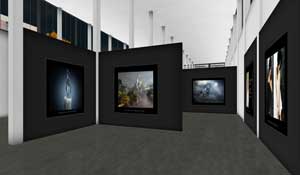 |
Virtual walk-through www 3D gallery |
The Internet dismantled the once-firm demarcations of what was permissible, sanctioned, and embraced, bestowing everyone the liberty to express themselves unreservedly. Ultimately, evaluating artworks was entrusted to the individual viewer, their viewpoints, values, and tastes. This unleashed a torrent of fresh names and artworks, effectively sidelining the role of critics and transcending the conventional constraints of galleries. It's now an open secret that exhibition halls often stand bereft of visitors, even when showcasing illustrious names, while the digital domain witnesses an overwhelming surge in traffic. The ease and accessibility of the Internet have resulted in online artwork views soaring to hundreds of times the footfall seen at any conventional exhibition.

The term "Neosurrealism" lacks a precise, fixed definition. It translates to "New Super Realism," combining Greek and French roots (from "neonate" and "surréalisme"), and thus its meaning remains rather fluid. Neosurrealism constitutes a vast and multifaceted movement, encompassing a multitude of branches and sub-divisions. Among these are Fantasy art, Psychedelic art, and Ar-Brut. In contrast to artistic Realism, which faithfully mirrors reality, Surrealism proves far more intricate and diverse. Super Realism, in its original conception, delved into the human subconscious and expressed it through a personal form of expression. Yet, the human subconscious remains a mysterious realm, in perpetual flux, continually expanding, reshaping, and unveiling new frontiers. The human consciousness and subconsciousness at the dawn of the 20th century markedly differ from their counterparts in the early 21st century. Surrealism, along with its contemporary iteration, Neo-surrealism, emerged with the purpose of expanding human consciousness. The question then arises: what is the path to such expansion? How do we elevate and transform our consciousness? The answer, it seems, lies in dismantling the familiar worldview.
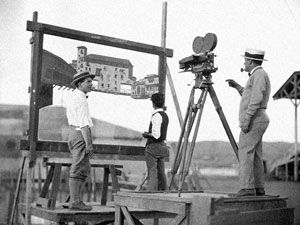 |
Glass Matte Painting in Cinema 1930 |
The emergence of surrealism in the early 20th century is frequently associated with the evolution of Earth's technology. It served as a response to the shifting realities of the time. For some artists, these new realities brought a surge of energy and optimism, while for others, it represented a tragic departure from traditional ethical and moral frameworks, leading to decay, degradation, and chaos. It's a notion that certainly holds some truth. Undoubtedly, the environment surrounding an artist influences them to the same extent as it does everyone else.
It appears logical to connect the genesis of Neo-surrealism with the advancement of computer technology. The advent of digital visualization platforms has undeniably broadened our concepts of imagery and granted the ability to manipulate it. With the rise of digital painting, photo manipulation, three-dimensional computer graphics, computer gaming, and the like, our knowledge and consciousness have discovered fresh avenues for development—expanding not just our horizons but even paving the way to entirely new realms, such as the Virtual World.
 |
Environment Modeling 3ds max 2010* |
Considering the technological dimension of Neo-surrealism's emergence, we can examine Matte-painting as an illustrative case. Initially, Matte-painting was a cinematic technique, blending a full-scale portion of the frame with a background pattern to conjure the illusion of an environment. It found applications in photography, television, and animation, serving to construct lifelike spatial settings. Over time, Matte paintings have transformed from hand-painted glass panels to complete 3D digital worlds.
This unassuming technological method for visual deception essentially gives birth to a form of super-reality or "sur-reality." When you witness something tangible on a two-dimensional screen, it's essentially a manipulation of reality. Another instance of reality manipulation can be observed in the graphical structure of a computer/video game. In these games, objects traverse through corridors and mazes where walls and ceilings consist of two-dimensional images of landscapes or interiors. Yet, the sense of three-dimensional reality conveyed on the screen remains unparalleled.
“Art is the lie that enables us to realize the truth.” ― Pablo Picasso
When we examine Neo-surrealism from a visual art perspective, it takes a contrasting path to the technological constructs of computer games. In the world of Neo-surrealism, artists craft juxtapositions where landscapes and interiors maintain unwavering realism, while the objects and actions set against these backgrounds transcend into the realm of pure fantasy. This technique seamlessly blends the elements of realism and fantasy, conjuring an illusion of reality within the unreal. This artistic practice instills a belief in the canvas, enabling the viewer to contemplate that what unfolds within it could indeed exist in reality, or at the very least, in a realm of imaginative reality. In this vast expanse interwoven with countless small illusions, one's perception blurs the boundaries between superimposed images, ultimately shaping a new dimension reminiscent of a vivid dream.

 |
The False Mirror 1928 - Rene Magritte |
"Have no fear of perfection - you'll never reach it." - Salvador Dali
The surrealism movement of the last century was marked by its diversity and enigmatic nature. Salvador Dali, in particular, spearheaded the realm of surrealist painting, steering it toward epatage (shock) and introducing a literary dimension to his works. Dali departed from the conventional practice of assigning mere numbers to his paintings, opting for extensive titles like "Sleep caused by the flight of a bee around a pomegranate, a second before awakening." This departure from abstract canvases aimed to infuse a unique literary component into his art, enhancing the depth of his work's perception.
On the other hand, René Magritte predominantly focused on creating compositions that aimed to provoke astonishment. While the technical quality of his paintings might be likened to that of an amateur artist, it in no way diminishes his originality and significant contribution to popularizing the surrealist movement.
Maurits Escher based his compositions primarily on mathematical principles. The subsequent to surrealism pop-art movement refused to paint at all, turning everything into a shocking pile of utilitarian and semi-utilitarian objects.
 |
Day and Night 1938 - M.C. Escher |
The primary objective of the surrealists was spiritual elevation and separation of the soul from the material. Here we come to the basics of the neo-surrealism definition. With the arrival of computer technology, artists and sculptors got an excellent opportunity to manipulate reality further. An advanced photo-manipulation appeared, it became possible to combine two and 3-dimensional spaces. Even to make alive the picture space by using computer algorithms and animation, such as Generative Art or Dynamic Painting.
These were technological possibilities that the pioneers of surrealism never had at their disposal. The original objective of surrealism, which revolved around separating the spirit from the material, gradually receded into the background, becoming a secondary concern. The focus shifted towards exploring the depth of the spirit, the richness of its diversity, and the multitude of colors it could offer, as the necessity to disentangle the spiritual and the material realms waned. Materiality found its own rightful place, and spirituality carved out its unique domain. Furthermore, the dimensions of the spiritual, conscious, and subconscious aspects of human existence are, in practical terms, nearly immeasurable and physically boundless.

 |
Blowing in the wind 2007 - Gilles Tran |
At first glance, defining the essence of Neosurrealism may appear straightforward: Neosurrealist work is art created in a surrealist style with the aid of a computer. However, it's not quite so cut and dry. Many may immediately pose the question: "What about traditional art forms like sculpture, painting, and drawing? If Neosurrealism, by your definition, is computer-based art, where do these traditional forms fit in?" The answer lies in the fact that any artwork crafted in the key, style, and spirit of surrealism, using any materials, falls under the purview of Neosurrealism today. Classical surrealism has transitioned into Neosurrealism simply due to the passage of a century since the movement's inception. The artists creating within this realm are products of the new millennium, characterized by worldviews, psychology, knowledge, objectives, consciousness, and subconsciousness strikingly distinct from the pioneers of the movement.
 |
Dissolution of Ego VI 2017 - Peter Gric* |
The age-old debate about the relative importance of traditional art, such as painting and drawing, versus computer graphics still persists. Yet, this dispute often lacks substantial merit. Both artistic modes represent personal expressions, differing only in the tools employed. Traditional forms rely on applied skills, while digital art leverages technology. Undoubtedly, computer technology currently dominates the art world and is likely to continue doing so in the near future. However, this in no way negates or diminishes the significance of traditional fine arts.
Numerous artists employ computer modeling as a preliminary step before transposing their creations onto the canvas, while others fully embrace digital creativity. Even artists of traditional painting prowess, such as Zdzislaw Beksinski, ventured into photo manipulation in the twilight of their careers. Digital art stands as a rightful successor to fine art, and a profoundly influential one at that. In the past, various art forms transitioned to different mediums, such as poetry evolving into songwriting and literature and theater finding new life in cinema. Nevertheless, the essence of traditional forms remains embedded in all these expressions. Engaging in debates about the relative importance of a movie versus a book seems rather simplistic. The answer is unequivocally both.
 |
Peach Blossom Island 2017 - Yuanxing Liang* |
New technological possibilities have enriched the perception of surrealism. The advent of three-dimensional printers, for instance, has shifted Neo-surrealistic sculpture from the confines of computer screens into the tangible realm of real life. It's vital to recognize that a computer is merely a tool, an instrument wielded to achieve individual visual objectives. The essential question revolves around the nature of these objectives. Computer art filters can instantaneously transform the same visual material into cubism, impressionism, or expressionism. However, it is a person who imparts the initial information for computerized processing, a person imbued with unique intentions and aspirations. Ultimately, it is this individual who evaluates the final image from an aesthetic perspective, drawing upon their education, vision, and innate talent.

“The most beautiful experience we can have is the mysterious. It is the fundamental emotion that stands at the cradle of true art and true science.” ― Albert Einstein
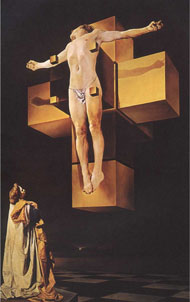 |
Crucifixion Corpus Hypercubicus 1954 - Salvador Dali |
In my perspective, a rather subtle way to define the artistic style of Neosurrealism is by evoking a sense of remarkable visual impact. When a viewer gazes upon a Neosurrealist artwork, they are often enveloped by a feeling of elevation and profound wonder. This sensation of wonder instills in the viewer a sense of spiritual ascent, growth, or even flight. It's no coincidence that throughout history, the image of the crucifixion of Christ was harnessed by religion to harness these very visual qualities.
Salvador Dali also employed this age-old symbol in his work. Ultimately, it matters less what the image portrays. If it manages to evoke a similar effect of elevating one's spirit, then it qualifies as a Neosurrealist work. Some might argue that this feeling of reverent wonder can be triggered by a wide array of stimuli, from ordinary objects to, in some cases, pathological conditions. While this holds truth, that's a discourse better suited for an entirely different essay, or perhaps even a psychiatric examination.
"One must still have chaos in oneself to be able to give birth to a dancing star." ― Friedrich Nietzsche
Any form of art has the potential to provoke a sense of awe. Whether through a paradoxical combination of objects, people, or landscapes that stirs questions about why and for what purpose, or through striking visuals like a submarine soaring in the sky, a ship navigating a sea of sand, or even flying elephants. Optical illusions involving object combinations also belong to this category. Each time one gazes at such an image, their subconscious mind serves up an array of questions and answers. The super-realistic impact is profoundly personal for each individual. The riddle before you lacks a single, definitive solution, as only the viewer can uncover answers based on their own experiences, worldview, reasoning, knowledge, and consciousness.
"Art is not what you see, but what you make others see." - Edgar Degas
“You might as well ask an artist to explain his art, or ask a poet to explain his poem. It defeats the purpose. The meaning is only clear thorough the search.”
― Rick Riordan

The rapid advancement of visual technologies holds enormous promise for the future of fine arts. Augmented reality (AR), artificial intelligence (AI), and the ever-increasing computational capabilities of computers are delivering progressively detailed digital worlds with high-resolution screens. In recent decades, many have envisioned virtual reality (VR) as the future of fine art. Some argue that VR has the potential to offer viewers a significantly more multidimensional and engaging experience compared to traditional static visual art forms.
 |
Artificial intelligence AI, augmented reality AR, virtual reality VR* |
Artists of the near future will introduce experiences featuring complete embodiment and almost tangible three-dimensional objects surrounding viewers. A young audience accustomed to such experiences will emerge. Present-day technology, such as "six degrees of freedom" (6DoF) immersion graphics, enables viewers to physically navigate within the created world. I foresee VR and AR expanding the color palette of traditional fine arts, with virtual reality headsets allowing viewers to seamlessly transition from a simple picture view to total immersion in a specific landscape, interior, or stage, all at the viewer's discretion.
Neo-surrealism, with its conceptual approach, is already embracing this transformation. Through techniques that prompt visual impulses, it seeks to enhance interactive communication with viewers, facilitate the exchange of information, and stimulate shifts in consciousness. Virtual reality technology is progressing rapidly, offering nearly limitless possibilities. The fine art of the future will no longer follow a one-way path from artist to viewer; it will evolve into a dialogue between two equals, an interactive space for the exchange of thoughts, making fine art the art of the conscious interplay.
Neo-surrealism is evolving continuously, with professional artists and amateur enthusiasts contributing to its growth. This movement persists and gains strength, amplified by ongoing discoveries and technologies. The boundaries of knowledge and self-discovery remain boundless. Countless contemporary artists are dedicated to seeking answers to the eternal question of being: "Who am I?" I, too, have endeavored to grapple with and reflect upon this profound inquiry in this brief exploration.
George Grie.
May 14, 2009
Title Rus - Манифест Нео-сюрреалиста.
* Illustrations added 2019
P.S.
Back when I penned the aforementioned text 15 years ago, extolling the marvels of emerging technologies, little did I foresee the need to append this postscript. The integration of artificial intelligence into the realm of art has not merely assisted artists in broadening their creative horizons; it has, rather remarkably, rendered the traditional notion of an artist obsolete. By "artist," I refer to individuals equipped with a formal education in fine art and its historical underpinnings—those who dedicated countless hours honing their drawing and painting prowess. While AI still necessitates human guidance for training and adjustments, the looming question remains: for how much longer?
AI has already surpassed human capabilities in terms of conceptualizing images and executing artistic prowess. It generates impeccably balanced and styled pictures that remain impervious to enhancement through human touch, running the risk of only deterioration. The AI revolution, akin to a perfect storm, yields two divergent outcomes. On the one hand, it grants millions devoid of formal art education a creative tool for artistic expression. On the other hand, it signals a seismic shift for present-day digital artists and graphic designers, compelling them to seek alternative vocations. It's a juxtaposition of sadness and inspiration.
Positive tidings await those artists dedicated to crafting art through manual means. Already a minority, they have evolved into a minute community distinguished by heightened skills, talent, and an even more unique creative prowess. This text serves as a brief reflection on current events, leaving room for speculation on what my musings might be 15 years hence.
George Grie. 2023